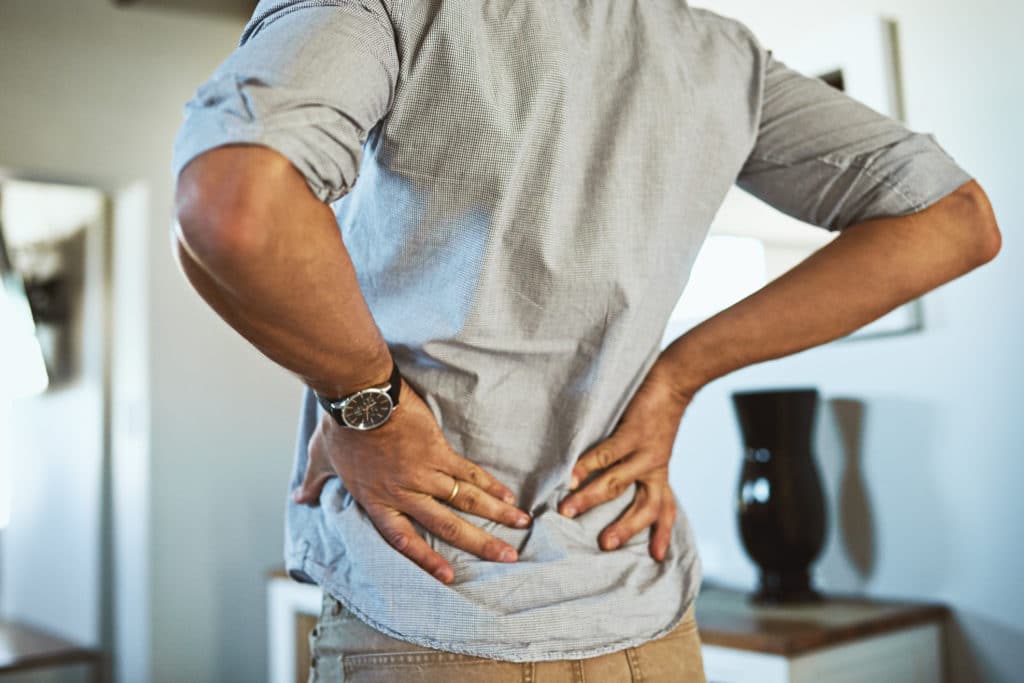When a patient has degenerative disc disease, recurrent disc herniation, or spondylolisthesis, there can be significant pain in the legs and lower back. Fusing two or more discs together can alleviate that pain by stabilizing the spinal vertebrae and the disc between them. If possible, Spine Surgeon, Dr. Todd J. Albert prefers to use the transforaminal lumbar interbody fusion (TLIF) technique for spinal fusion. He believes TLIF delivers excellent outcomes in the appropriate patient population.
If you are interested in learning more about the TLIF procedure and whether you are a candidate, be sure to call 212-606-1004 today to schedule your consultation with Dr. Albert!
What Is A Transforaminal Lumbar Interbody Fusion (TLIF)?
Transforaminal lumbar interbody fusion (TLIF) is a procedure that fuses the anterior and posterior columns of the spine through a posterior approach. TLIF is a technique used for spinal fusion that inserts a bone graft and an artificial disc spacer into the area of the degenerated disc through a lateral approach to the spine. To gain access, only the facet joints on one side of the posterior spine are removed. This approach results in less disturbance to the nerve roots, reducing the risk of scarring or injury to them. The end result is the same as in other fusion techniques — fusion of two or more discs and stabilization of that part of the spine.
Am I A Candidate For TLIF Surgery?
Degenerative disc disease isn’t really a “disease” but a term that describes how the spinal discs change with age. The discs consist of outer membranes of connective tissue enclosing soft, jellylike material in the middle. They act as shock absorbers between the vertebrae of the spine, allowing the spine to twist, bend, and flex.

As we age, the spinal discs break down (degenerate) and become less fluid. They can flatten and push outward (herniate), pushing on nearby nerves or the spinal cord.
The disc’s outer membrane can tear, also impacting the spinal cord and nerves. Degenerative disc disease often will lead to the need for disc fusion to alleviate pain in the legs and back.
Other patients needing fusion may have conditions such as spondylolisthesis, a condition in which one vertebra slips forward over the one below it, impacting the nerves and sending pain into the lower back and/or the legs. Spinal stenosis, where the nerves exiting the spine become compressed either by bone spurs or a narrowing of the spinal canal, can also lead to fusion surgery.
A degenerated disc or nerve impingement in the lower back (lumbar) may result in pain in the back, buttocks, or legs. If the pain does not respond to nonsurgical treatments, or even to decompression surgery to relieve compression, it may be time to consider fusion. Odds are the pain will increase and begin to impact your quality of life.
Transforaminal Lumbar Interbody Fusion Vs. Posterior Lumbar Interbody Fusion
An alternative to TLIF surgery is to use posterior lumbar interbody fusion (PLIF). Prior to TLIF procedures becoming more common, PLIF was the method usually used. In PLIF, the bone graft is placed between the vertebrae, as it is in TLIF surgery. The difference is that the bone graft is inserted into the disc space from the back (posterior), versus from the side in TLIF.
Dr. Albert believes TLIF is the preferable method. TLIF accesses the degenerated disc through one side, removing only the facet joint from the vertebra on that side. The TLIF method avoids significant retraction of the dura and nerve roots. This reduces the chances of nerve injury and scarring. It also requires less muscle retraction than PLIF, making for a faster, easier recovery.
Preparing For TLIF Surgery
If you smoke, it’s critical to stop for at least 12 months after your fusion surgery. Smoking impairs the fusion process and degrades outcomes. If you are obese, it is advised to lose weight prior to having this surgery, to help alleviate some of the pressure on your spine.

As with all surgeries, you’ll need to stop taking aspirin, herbal supplements, and any blood-thinning medications at least two weeks prior to surgery.
If you take anti-clotting medication, you may need to be admitted to the hospital 3-4 days prior to your surgery to allow the drugs to wear off.
Dr. Albert may have you take a zinc tablet once daily from one month prior to surgery through three months afterwards.
The TLIF Procedure Explained
Prior to TLIF, bone graft material was taken from the patient’s hip through a small incision. This material was then used to fuse the vertebrae. Now the TLIF procedure proceeds.
- An incision is made on the back at the site of the damaged disc. To gain access to the disc laterally, Dr. Albert first removes the facet joints (part of the back side of the vertebra) on one side.
- Next, the damaged disc is partially removed, leaving some of the disc wall to help contain the bone graft material.
- An interbody spacer is then inserted into the empty disc space. This will return proper spacing between the vertebrae, lifting the pressure from the nerve roots that are being pinched or compressed. The area is also filled with a morselized bone to aid in the fusion of the two vertebrae.
- Screws and rods (one on each side) are inserted to add additional support between the vertebrae being fused. The bone graft material is placed over these rods on the sides of the spine. This morselized bone will then grow all around and through the rods to form a bone bridge on both sides of the two vertebrae.
- The incision is closed and the procedure is finished.
Is TLIF Surgery Painful?
The TLIF procedure is performed under general anesthesia. The pain-blocking effects of anesthesia wear off over several hours. During the initial postoperative recovery in the hospital, prescription pain medication may be given via an IV or oral administration at regular intervals. This keeps discomfort to a minimum while patients are beginning their early physical therapy.
Bone Graft Material
The bone graft material placed in the disc and onto the stabilizing rods and screws is obtained from the patient’s iliac crest, which is the border of the wing of the ilium, the largest bone of the pelvis.
How Long Does The Transforaminal Lumbar Interbody Fusion Procedure Take?
The length of this procedure depends on the number of levels that are being fused. A one level transforaminal lumbar interbody fusion typically takes between 2-3 hours.
What Are The Technique Benefits Of TLIF Back Surgery?
There are various techniques that can be used to fuse two vertebrae’s together, but Dr. Albert chooses the TLIF procedure when possible. Advantages include the following:
- Bone fusion has three strong sites, on both gutters of the posterior of the spine, and inside the disc space.
- The spacer inserted into the middle of the empty disc opens the space back up, alleviating the pressure on the nerve roots.
- By being able to access the disc area from one side, the nerve roots don’t need to be retracted as much. This reduces the chances of injury and scarring, and it then makes for a somewhat easier recovery.
Is The Transforaminal Lumbar Interbody Fusion Procedure Safe?
The TLIF procedure is a common technique for the treatment of symptomatic degenerative disc disease and spondylolisthesis. The results of the procedure are generally excellent. According to published research studies, between 90 and 96 percent of patients achieve good or excellent results from their surgery.
Surgical risks associated with TLIF include bleeding, infection, and poor wound healing. Patients are advised to quit smoking and discontinue the use of any nicotine products before this procedure and for at least 12 weeks after surgery. The risks associated with surgery are also discussed at length during our consultation.
Post-Op Care For TLIF Surgery
Lumbar fusion surgery is major surgery. Most patients having TLIF surgery will stay in the hospital for between one to three days. Physical therapy then begins the day after surgery. You will have to limit your activity, making sure to avoid twisting the spine, but walking during your recovery will be important. The worst pain will generally be over by two to three weeks after your surgery.

The period from one to three months after surgery is a crucial time for the fusion mass to become solid. You will need to avoid certain activities, such as, running or jogging.
Physical Therapy
Physical therapy may begin as early as the day after surgery. Most patients return home within 2-3 days of their procedure and continue an at home physical therapy program there. The goals of this program are to teach the patient how to get in and out of bed safely and how to walk independently.
It is important to avoid bending at the waist and also twisting at the waist for 2 to 4 weeks. Lifting is limited to 5 pounds or less. Once comfort and mobility improve, around 4 to 6 weeks after surgery, patients will be able to bend, lift, and twist again and will start an outpatient physical therapy program.
When Can I Return To My Normal Activities After My Transforaminal Lumbar Interbody Fusion?
Patients may begin to drive a week to two weeks after their procedure. Driving cannot resume until the patient is no longer taking narcotic pain medication. When driving resumes, it is necessary to begin with short drives and to have another person in the vehicle who could take over if pain flares up. As comfort improves, patients are able to drive longer distances.
Light duties may resume 2 to 3 weeks after surgery, depending on comfort. Moderate level work and light sporting activities may resume approximately 3 months after surgery, provided that pain has subsided and strength and flexibility have improved through physical therapy.
Patient Testimonial
"I can honestly say that Dr. Albert is above yelp reviews. He is a top-notch spine surgeon and I attribute getting my life back to him. I had two surgeries with him and I cannot even begin to state how incredibly kind and talented he is. He went above and beyond for me. Most importantly, his skill is unmatchable and his position at the top orthopedic hospital proves so."
"Dr. Albert and his staff provide an extremely high level of care. He is the consummate professional in his area of expertise. Not only is he an excellent doctor, but he is also a very well-rounded human being. As a patient, I feel both confident in his surgical abilities and his personal caring approach to my surgical needs. I have recommended him to a number of my friends and coworkers."
What Will Be My TLIF Surgery Results?
The results of this surgery vary by the patient. The goals are to:
- Reduce leg pain, numbness, tingling, and weakness.
- Reduce back pain
- Stabilize the spine
- Regain strength and stop the deterioration
- Improve lower back and leg function
- Return quality of life
Overall, over 70 percent of patients will obtain significant improvement from this surgery with Dr. Albert. These results are maintained long term. While few patients become completely free of symptoms, there is usually significant improvement and a return to normal life and activities.

TLIF Surgery Risks
When considering TLIF surgery, you’ll of course have to weigh the benefits against the potential complications and risks. TLIF spinal surgery generally results in solid bone fusion and good pain improvement, but there are risks. These include the risks of any major surgery (infection, anesthesia reaction, etc.), along with nerve injury, lack of solid fusion between the vertebrae, or continued pain.
Studies of TLIF surgery show that a majority of patients report a 60-70% improvement in pain and are able to return to their normal activities.
Schedule A Consultation For TLIF Surgery In Our NYC Location
Learn more about TLIF back surgery and find out if you are a candidate. Call 212-606-1004 to schedule a consultation in New York with Dr. Albert. Or, you can fill out the form in our contact page for your one-on-one appointment.


